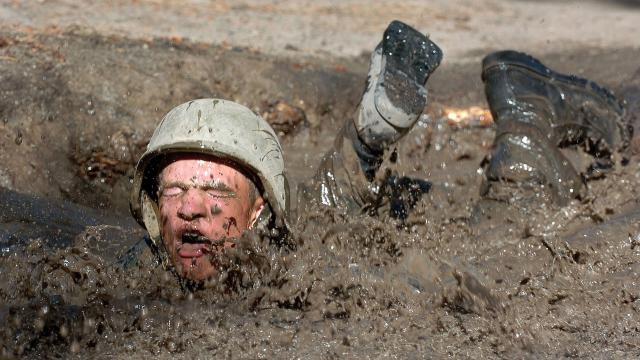As a child, I knew two things about quicksand: that it’s a go-to peril for cartoon characters in jungles, and that in real life, it’s only sticky if you treat it like a solid. Pretend it’s water, and you can swim out of it.
But it’s not always that simple. Recently a man was trapped for 12 hours in quicksand in Zion National Park in Utah. He couldn’t get out, his girlfriend couldn’t get him out, the first park ranger who arrived couldn’t get him out, and when the ranger tried to pull with a rope, he said it felt like his leg was going to be ripped off. Eventually a team of park rangers was able to get him out. It was snowing almost the whole time he was trapped, and he needed to be treated for hypothermia.
What is quicksand?
Quicksand is a mixture of solid particles (like sand) and water. When your foot presses down on it, your weight squeezes the water out from between the particles. That leaves you trapped by mud that feels nearly solid. Check out this video, where the host walks onto what looks like solid ground, and sinks. Within a few minutes, he’s surrounded by a puddle of displaced water. Also, he is a little more trapped than he expected to be:
What to do when you first get stuck
You become stuck because you have a lot of weight (your whole body) pushing down on a small footprint (your, well, footprint). Make yourself lighter by taking off your backpack or any gear that adds to your weight.
It’s hard to sink if you’re horizontal, so consider trying to lay down in the mud before you get your legs stuck. And if you have anything else that can spread out the weight, like hiking poles or anything shaped like a flat board, lay it across the mud and use it for support.
It’s better to try to get out backwards, laying down on your back rather than your stomach, because you’re less likely to get your face in the mud.
How to free someone who’s really trapped
Once your legs are stuck, you’re at a serious disadvantage. Your hiking buddy can’t just pull you out with a rope, because there’s no way for air to enter the space that you’ve made with your legs. Basically, you’ve created a vacuum so strong that pulling you out requires the same force needed to lift a car.
In the video below, a coast guard crew surrounds a stuck person with boards so they can kneel and work. Then they pump water into the sand around the person, and dig out the sediment.
In the video we saw above, the presenter saves himself on his own—just barely—by making small movements with his legs to allow water to settle into the space beneath him.
How to avoid quicksand in the first place
Don’t underestimate quicksand. People don’t usually drown in it, but you can definitely get trapped and become vulnerable to heat exhaustion, hypothermia, or other dangers of the elements.
Start by knowing where quicksand is likely to occur, and be careful around marshes, tidal flats, and other swampy areas. Water bubbling up from under the ground is a definite warning sign. Tap the ground in front of you with a stick if you have any doubt about how solid it is. Quicksand will visibly give way.
In these areas, it’s especially important to follow basic wilderness safety: carry a phone or radio if possible, and tell someone where you’re going and when you plan to be back.

Comments